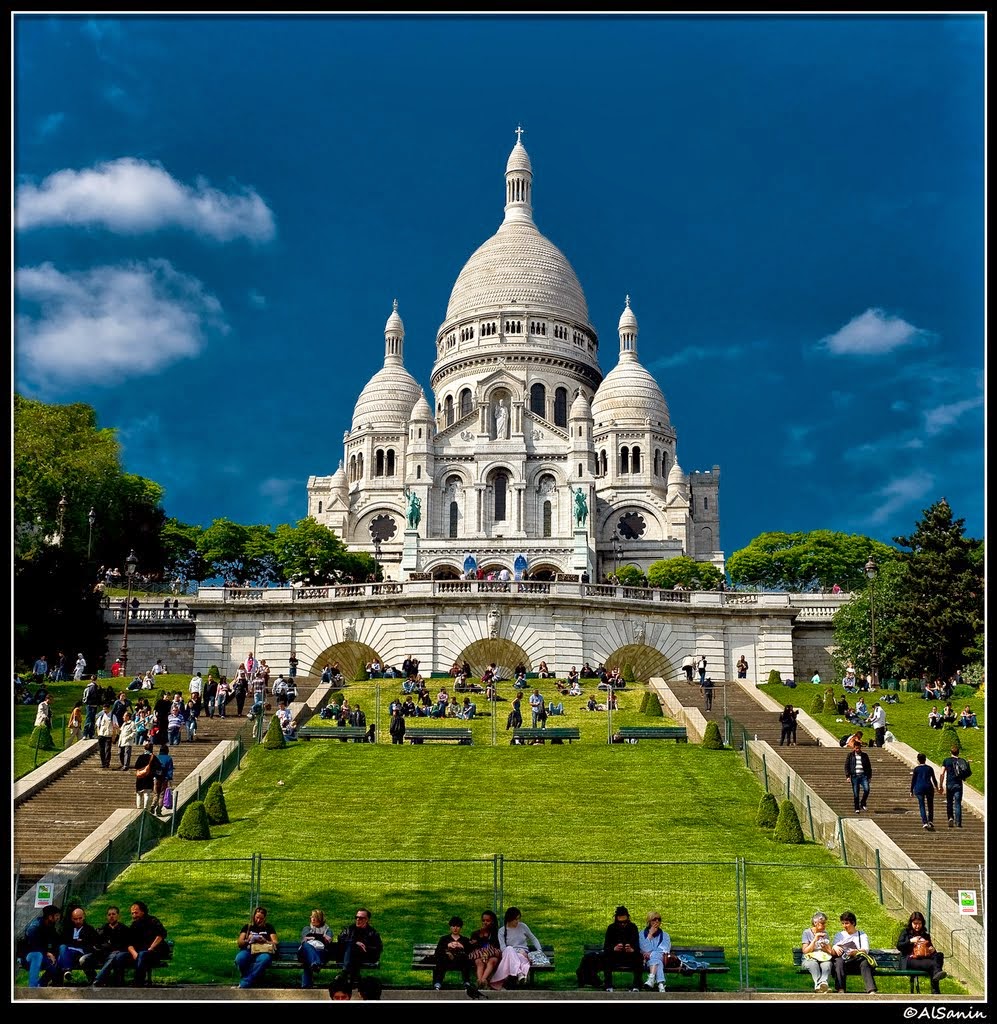The Basilica of Sacré-Cœur, perched atop Montmartre, is more than just a stunning architectural landmark; it’s a symbol of faith, repentance, and national reconciliation. Its dazzling white silhouette dominates the Parisian skyline, drawing millions of visitors each year. And while the basilica itself is a masterpiece of Romanesque-Byzantine design, the monumental staircase that leads to its doors is an integral part of the Sacré-Cœur experience, offering both a physical challenge and breathtaking panoramic views.
A History Forged in Turmoil:
The story of the Sacré-Cœur is deeply intertwined with the tumultuous history of France in the late 19th century. The Franco-Prussian War (1870-1871) was a devastating defeat for France, culminating in the siege of Paris and the bloody suppression of the Paris Commune. In the aftermath of this national trauma, the idea of building a basilica dedicated to the Sacred Heart of Jesus emerged.
Alexandre Legentil and Rohault de Fleury, prominent figures within the Catholic Church, attributed France’s misfortunes to a moral decline and a perceived abandonment of religious values. They proposed the construction of a church as an act of national penance, a way to atone for the sins of the French people and implore divine forgiveness. This proposal resonated with many, especially within conservative and Catholic circles, who saw it as a way to restore traditional values and heal the wounds of war.
The National Assembly officially approved the project in 1873, declaring it a matter of national importance. The choice of Montmartre as the location was also significant. According to tradition, Montmartre (meaning "Mount of Martyrs") was the site where Saint Denis, the first Bishop of Paris, was beheaded in the 3rd century. It was also an area associated with radical politics and the Commune uprising, making it a symbolically charged location for a basilica intended to represent national unity and religious devotion.
Architecture: A Blend of Styles and Symbolism:
The design of the Sacré-Cœur was entrusted to Paul Abadie, who won a national competition with his Romanesque-Byzantine architectural plan. Abadie’s vision was a departure from the Gothic style that dominated many Parisian churches. He drew inspiration from Byzantine churches like Hagia Sophia in Istanbul and Romanesque cathedrals in the Périgord region of France.
The basilica’s most striking feature is its dazzling white exterior, achieved through the use of Château-Landon stone, a type of travertine that hardens and self-cleans over time, ensuring its perpetual brilliance. The central dome, reaching a height of 83 meters (272 feet), dominates the skyline and provides stunning views from its summit.
The interior of the basilica is equally impressive. The vast mosaic above the altar, "Christ in Glory," is one of the largest in the world, depicting Jesus Christ with his arms outstretched, inviting all to come to him. Stained glass windows filter light throughout the space, creating a serene and contemplative atmosphere. The crypt beneath the basilica houses a collection of relics and tombs, adding another layer of historical and religious significance.
The Staircase: A Pilgrimage in Steps:
The monumental staircase leading up to the Sacré-Cœur is an essential part of the visitor experience. It’s not just a way to reach the basilica; it’s a journey in itself, a physical ascent that mirrors the spiritual ascent sought by pilgrims.
The staircase is comprised of several flights of steps, totaling over 200 individual steps. These steps are wide and relatively shallow, making the climb manageable for most visitors, although those with mobility issues may find it challenging. Several landings provide opportunities to pause, catch your breath, and admire the ever-expanding panoramic view.
The View from the Top: A Parisian Panorama:
The reward for conquering the staircase is the breathtaking panoramic view of Paris that unfolds before you. From this elevated vantage point, you can see iconic landmarks such as the Eiffel Tower, Notre Dame Cathedral, the Louvre Museum, and the Arc de Triomphe. On a clear day, the view extends for miles, offering a truly unforgettable perspective of the city.
The staircase itself becomes a stage for Parisian life. Street performers entertain the crowds with music, magic, and mime. Vendors sell souvenirs, postcards, and refreshments. Tourists and locals alike gather to enjoy the view, soak up the atmosphere, and capture the moment with photographs.
Practical Information for Visitors:
- Location: The Basilica of Sacré-Cœur is located at the summit of Montmartre, in the 18th arrondissement of Paris.
- Getting There:
- Metro: The nearest metro stations are Abbesses (Line 12) and Anvers (Line 2). From Abbesses, you can take the funicular up the hill (requires a metro ticket). From Anvers, it’s a slightly longer, but more scenic, walk up the Rue de Steinkerque to the base of the staircase.
- Bus: Several bus lines serve Montmartre, including the Montmartrobus, a small bus that winds its way through the narrow streets of the neighborhood.
- Opening Hours: The basilica is generally open daily from 6:00 AM to 10:30 PM. The dome is open from 8:30 AM to 8:00 PM (May to September) and 9:00 AM to 5:00 PM (October to April).
- Admission: Admission to the basilica is free. However, there is a small fee to climb to the dome.
- Accessibility: The staircase is not accessible to wheelchairs or those with limited mobility. The funicular provides an alternative route to the top of Montmartre, but it still requires navigating some steps to reach the basilica entrance.
- Security: Be aware of your surroundings and take precautions against pickpockets, especially in crowded areas.
- Respectful Attire: As a place of worship, visitors are asked to dress respectfully. Shoulders and knees should be covered.
The Sacré-Cœur Experience: Beyond the View:
Visiting the Sacré-Cœur is more than just seeing a beautiful building and enjoying a stunning view. It’s an immersive experience that engages the senses and invites reflection.
- Attend a Mass: Experiencing a mass at the Sacré-Cœur can be a powerful and moving experience, especially with the beautiful acoustics and the sense of community.
- Explore the Crypt: Descend into the crypt to discover a hidden world of chapels, relics, and tombs.
- Climb to the Dome: The panoramic view from the dome is even more spectacular than the view from the staircase.
- Wander Through Montmartre: Explore the charming streets of Montmartre, discover hidden cafes, and visit the Place du Tertre, where artists create and sell their work.
Conclusion:
The Basilica of Sacré-Cœur and its iconic staircase represent a powerful symbol of Parisian history, faith, and resilience. The climb up the staircase is a physical challenge that rewards visitors with breathtaking panoramic views of the city. But beyond the stunning architecture and the captivating scenery, the Sacré-Cœur offers a deeper experience, a chance to connect with history, art, and spirituality in the heart of Paris. It is a must-see destination for anyone seeking to understand the soul of the city. The basilica is a constant reminder of the turbulent past, the enduring power of faith, and the unwavering beauty that can emerge from even the most challenging circumstances. The journey to the top, both literally and figuratively, is an experience that will stay with you long after you’ve descended the steps and left Montmartre behind.

